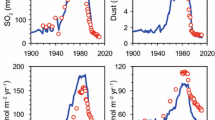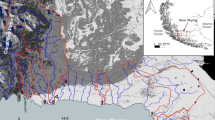Abstract
Sulphate (SO −24 ) concentrations in 34 intensively measured Canadian Shield streams near the Dorset Research Centre, central Ontario, were used to test a hydrogeologic model that uses simple measures of wetland area and till depth to identify catchments that produce SO −24 pulses. Mean annual measured maximum SO −24 concentrations were significantly greater in shallow till (<1 m depth) catchments containing wetlands than catchments covered with deeper tills (>1 m depth) containing wetlands or catchments with no wetlands. Average maximum SO −24 concentrations in wetland catchments during years with dry summers were >20 mg/L in 19 of 20 catchments with average till depths of <1 m, whereas concentrations were <20 mg/L in 5 of 6 watersheds with average till depths of >1 m. Peaks in mean annual maximum SO −24 concentrations from wetland catchments with shallow till occurred during summers with rain fall 150–200 mm less than potential evaporation estimates. There were no significant differences in mean average annual SO −24 concentration among the different catchments during wet summers, with SO −24 concentrations ranging from 6 to 13 mg/L. These observations suggest that a large portion of the temporal and spatial variation in SO −24 chemistry and export can be predicted in headwater catchments of the Canadian Shield and perhaps in other landscapes where till depth influences upland-wetland hydrologic connections.
Similar content being viewed by others
References
Bayley SE, Behr RS & Kelly CA (1986) Retention and release of S from a freshwater wetland. Water, Air, Soil Pollut. 31: 101–114
Braekke FH (1981) Hydrochemistry in low-pH soils of south Norway. 1. Peat and soil water quality. Reports of the Norwegian Forest Research Institute 36(11): 1–32
Brown KA & MacQueen JF (1985) Sulphate uptake from surface water by peat. Soil Biol. Biochem. 17(4): 411–420
Bunting MJ, Warner BG & Aravena R (1996). Later Quaternary vegetation dynamics and hydroseral development in aThuja occidentalis swamp in southern Ontario. Can. J. Earth Sci. 33: 1439–1456
Chapman LJ (1975) The Physiography of the Georgian Bay-Ottawa Valley Area of Southern Ontario. Ontario Div. Mines, GR128, 35 p.
Devito KJ (1994) The Hydrologic Control of Sulphur Dynamics in Headwater Forested Wetlands on the Canadian Shield. PhD Thesis, York University, North York, Ontario, 210pp.
Devito KJ (1995) Sulphate mass balances of Precambrian Shield wetlands: The influence of catchment hydrogeology. Can. J. Fish. Aquat. Sci. 52: 1750–1760
Devito KJ & Dillon PJ (1993). The influence of hydrologic condition and peat oxia on the phosphorous and nitrogen dynamics of a conifer swamp. Water Resour. Res. 29: 2675–2685
Devito KJ, Hill AR & Roulet NT (1996) Groundwater — surface water interactions in headwater forested wetlands of the Canadian Shield. J Hydrol. 181: 127–147
Devito KJ & Hill AR (1997) Sulphate dynamics in relation to groundwater — surface water interactions in headwater wetlands of the southern Canadian Shield. Hydrological Processes 11: 485–500
Devito KJ & Hill AR (1998) Sulphate mobilization and pore water chemistry in relation to groundwater hydrology and summer drought in two conifer swamps on the Canadian Shield. Water, Air, Soil Pollut. (in press)
Dillon PJ, Molot LA & Scheider WA (1991) Phosphorus and nitrogen export from forested stream catchments in central Ontario. J. Environ. Qual. 20: 857–864
Dillon PJ & LaZerte BD (1992) Response of the Plastic Lake catchment, Ontario, to reduced sulphur deposition. Environ. Pollut. 77: 211–217
Dillon PJ, Molot LA & Futter M (1997) The effect of El Nino-related drought on the recovery of acidified lakes. Int. J. Environ. Mon. Assess. 46: 105–111
Feijtel TC, Salingar Y, Hordijk CA, Sweerts JPRA, Van Breemen N & Cappenberg TH (1989) Sulphur cycling in a Dutch moorland pool under elevated atmospheric S-deposition. Water, Air and Soil Pollut. 44: 215–234
Girard R, Reid RA & Snyder WR (1985) The Morphometry and Geology of Plastic and Heney Lakes and Their Catchments. Ontario Ministry of the Environment, Data Report DR 85/1, 29pp.
Gosling L & Baker SJ (1980) Acidity fluctuations at a broadband site in Norfolk. Freshwater Biology 17: 479–490
Holopainen IJ & Oikari A (1992) Ecophysiological effects of temporary acidification on Crucian carp, Carssius carassius. Ann. Zool. Fennici 29: 29–38
Jeffries DS & Snyder WR (1983) Geology and Geochemistry of the Muskoka-Haliburton Study Area. Ontario Ministry of the Environment, Data Report DR 83/2, 101 pp.
LaZerte BD (1993) The impact of drought and acidification on the chemical exports from a minerotrophic conifer swamp. Biogeochemistry. 18: 153–175
Manabe S & Wetherald RT (1986) Reduction in summer soil wetness induced by an increase in atmospheric carbon dioxide, Science. 232: 626–629
Mierle G (1990) Aqueous inputs of mercury to Precambrian Shield lakes in Ontario. Environm. Toxicol. Chem. 9: 843–851
Ontario Ministry of Environment (OME) (1984) Outlines of Analytical Methods. Ont. Min. Environ., Water Research Branch, Rexdale, Ontario. 246 p.
Riley JL (1988) Peat and Peatland Resources of Southeastern Ontario. Mines and Minerals Div., Ontario Geological Survey, Ontario Ministry of Northern Development and Mines,Open File Rep. 5633, 283 p.
Roulet NT, Moore T, Bubier J & Lafleur P. (1992) Northern fens: Methane flux and climate change. Tellus 44B: 100–105
Schindler DW, Curtis PJ, & Parker BR (1996) Consequences of climate warming and lake acidification for UV-B penetration in North American boreal lakes. Nature 379: 705–708
Sparling JH (1966) Studies on the relation between water movement and water chemistry in mires. Can. J. Bot. 44: 747–758
Urban NR, Eisenreich SJ & Grigal DF (1989) Sulfur cycling in a forested Sphagnum bog in northern Minnesota. Biogeochemistry 7: 81–109
Van Dam H (1988) Acidification of three moorland pools in The Netherlands by acid precipitation and extreme drought periods over seven decades. Freshwater Biology 20: 157–176
van Haesebroeck V, Boeye D, Verhagen B & Verheyen RF (1997) Experimental investigation of drought induced acidification in a rich fen soil. Biogeochemistry 37: 15–32
Velleman PF (1995) Data Desk (version 5.0): Statistics Guide 3: Learning and Using Statistics Procedures. Data Description Inc., Ithaca NY
Wieder RK (1985) Peat and water chemistry at Big Run Bog, a peatland in the Appalachian mountains of West Virginia, USA. Biogeochemistry 1: 277–302
Wieder RK & Lang GE (1988) Cycling of inorganic and organic sulfur in peat from Big Run Bog, West Virginia. Biogeochemistry 5: 221–242
Winter TC & Woo M-K (1990) Hydrology of Lakes and wetlands. In: Wolman MG & Riggs HC (Eds) Surface Water Hydrology, Vol. 0–1 (pp 159–187). Geological Society of America, The Geology of North America, Boulder, CO
Wright RF & Schindler DW (1995) Interaction of acid rain and global changes: Effects on terrestrial and aquatic ecosystems. Water, Air and Soil Pollut. 85: 89–99
Yan ND, Keller W, Scully NM & Lean DRS (1996) Drought, acidification and the attenuation of ultraviolet light in lakes: Linking three environmental Stressors. Nature 381: 141–143
Author information
Authors and Affiliations
Rights and permissions
About this article
Cite this article
Devito, K.J., Hill, A.R. & Dillon, P.J. Episodic sulphate export from wetlands in acidified headwater catchments: Prediction at the landscape scale. Biogeochemistry 44, 187–203 (1999). https://doi.org/10.1007/BF00992978
Accepted:
Issue Date:
DOI: https://doi.org/10.1007/BF00992978




